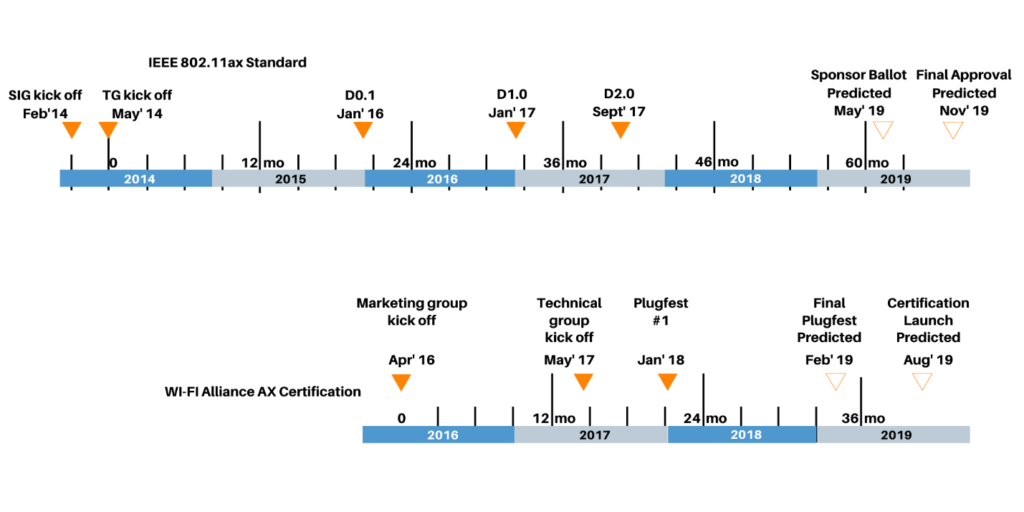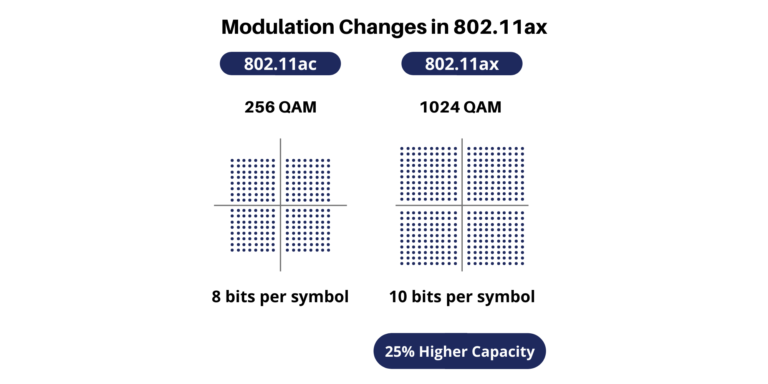Wifi 6: is this the next step
In the world of gaming, streaming, and video calls, one aspect is especially important that is bandwidth speeds, the increasing qualities and framerates require more and more high-speed data transmission, and for that technologies must evolve with time. Wi-Fi 6 is a big step in that direction, with this the things are going to get better, speedier, and great quality. If you want to know more about how this technology is going to work and affect your internet use, this is the post for you.
Here Goes – What exactly is Wi-Fi 6 or 802.11ax?
Wi-Fi 6 is an industry certification program based on the IEEE 802.11ax standard. With the evolution of Wi-Fi standards, Wi-Fi Alliance (WFA) renames Wi-Fi standards using sequence numbers to help Wi-Fi users and device vendors easily learn about their connection and supported Wi-Fi device models. Wi-Fi 6 enables the next generation Wi-Fi connectivity promising higher capacity, coverage, and performance even in hyper-dense environments. These networks enable lower battery consumption making them perfectly suited for modern connected applications, such as smart homes, Internet of Things, and Smart Manufacturing. It is the improved version of the previous Wi-Fi technology Wi-Fi 5 (802.11ac). The origin of Wi-Fi 6 came into being because of the constantly growing number of devices that require the internet with high bandwidth-demanding applications, and in this release, it resolves most of these issues.

Wireless Standards Over Time
Release Year | 802.11 Standard | Frequency Band | New Name |
| 802.11n | 2.4 GHz or GHz | Wi-Fi 4 |
2013 | 802.11ac Wave 1 | 5 GHz | Wi-Fi 5 |
2015 | 802.11ac Wave 2 | 5GHz |
|
2019 | 802.11ax | 2.4 GHz or 5 GHz | Wi-Fi 6 |
802.11n (2008) | 802.11ac (2012) | 802.11ax (2018) |
• 2.4 and 5 GHz • 40 MHz Channels • 64-QAM Rates • Up to 4 Streams • Beamforming (explicit and implicit) • Backwards compatibility with 11a/b/g | • 5 GHz only • 80 and160 MHz Channels • 256-QAM Rates • Up to 8 Streams • Beamforming (explicit) • Multi-user MIMO • Backwards compatibility with 11a/b/g/n | • 2.4 GHz and 5 GHz • 1024-QAM Rates • Multi-user MIMO, 8 clients • OFDMA uplink and downlink • Better battery life (Target Wake Time) • Spatial re-use (BSS color) • Enhanced outdoor long-range performance • Backwards compatibility with 11a/b/g/n/ac |
Enhancements in 802.11ax
High-Efficiency-Wireless (HEW) or Wi-Fi 6
In reality, How fast is it?
The theoretical answer is up to 9.6 Gbps increasing from 3.5 Gbps in Wi-Fi 5. The speed could get as much as 30% faster from its predecessor. Wi-Fi 6 can provide higher speed by implementing advanced data encoding (1024 QAM) and using the upgraded chips to encode and decode these signals and thus packing more data into the same signal space. However, you might still not be able to utilize the full advantage of WI-Fi 6 as most ISPs do not provide the speeds that this new technology can get up to.
What are the core technologies of Wi-Fi 6?
The Wi-fi 6 consists of two main techs that are an upgraded version of
- OFDMA – Orthogonal frequency division multiple access
- DL/UL MU-MIMO – Downlink/uplink multi-user, multiple input, multiple output
- Higher-order modulation technology (1024-QAM)
- Spatial Reuse (SR) & basic service set (BSS) coloring mechanism
- Extended Range – Longer OFDM symbol
- OFDMA
802.11ax introduces a more efficient data transmission mode, which is called OFDMA. 802.11ax supports the uplink and downlink MU mode; therefore, this mode can also be called MU-OFDMA. It allows multiple users to reuse channel resources by allocating subcarriers to different users and adding multiple access in the OFDM system. The 802.11ax standard defines the smallest subchannel as a resource unit (RU). Each RU includes at least 26 subcarriers, and users are distinguished by time-frequency RUs. The resources of the entire channel are divided into small fixed time-frequency RUs. In this mode, user data is carried on each RU. Therefore, on the total time-frequency resources, multiple users may simultaneously send data on each time segment.
- DL/UL MU-MIMO
OFDMA complements another feature worth mentioning called multi-user, multiple input multiple output, or MU-MIMO for short. MU-MIMO uses the spatial diversity of channels to transmit independent data streams on the same bandwidth.
Unlike SU-MIMO in earlier 802.11 standards, MU-MIMO was introduced in Wi-Fi 5 which greatly improves the throughput and the entire network. In 802.11ax, the number of MU-MIMO is further increased from DL 4×4 MU-MIMO, and DL 8×8 MU-MIMO is supported.
UL MU-MIMO is an important feature introduced in 802.11ax. Similar to UL SU-MIMO, UL MU-MIMO uses the same channel resources to transmit data on multiple spatial streams by using the multi-antenna technology of the transmitter and receiver.
High-performance experience with multi-user features
OFDMA (uplink and downlink) and MU-MIMO (downlink)
OFDMA increases capacity | MU-MIMO increases capacity |
OFDMA reduces latency for voice and IoT | MU-MIMO results in higher speed and throughput per user – transmit to up to 8 clients |
Ideal for low bandwidth, small packets (voice and IoT), latency sensitive applications | Ideal for higher bandwidth applications such as HD Video or large files |
- 1024-QAM
With 1024QAM, Wi-Fi 6 can deliver a 25% increase in capacity over 256 – QAM, particularly at close distances. With 1024-QAM, each symbol carries 10 bits rather than 8 bits, improving raw speeds compared to 802.11ac 256-QAM. This makes the streaming experience much better for users.

- BSS Coloring
802.11ax introduces a new co-frequency transmission identification mechanism called BSS (Basic Service Set) coloring. Wi-Fi 6, BSS coloring is another method to differentiate between BSSs (that is, access points and their devices) on the same channel. The BSS color field is added to the PHY packet header to color data from different BSSs and allocate a color to each channel. If the colors are the same, we can tell that the interference signals come from the same BSS, and signal transmission should be delayed. If the colors are different, no interference exists between the two Wi-Fi devices. The two Wi-Fi devices can then transmit data on the same channel and at the same frequency.
- Extended Range – Longer OFDM symbol
OFDM is a symbol that transmits data. It divides its data among smaller subcarriers for more stability and wider coverage. Wi-Fi 6 uses a 4x longer OFDM symbol to create 4x more subcarriers. Because of this, Wi-Fi 6’s longer OFDM symbol provides increased coverage and makes it 11% faster. A long OFDM symbol will ensure the arrival of clean data packets and reduce retransmission times, which increases coverage distance.
Benefits of Wi-Fi 6
Wi-Fi 6 brings in significant improvements through key enabling technologies such as MU-MIMO, OFDMA, BSS Coloring, Longer OFDMA symbol, etc. to achieve faster and highly optimized Wi-Fi performance. Some other features of Wi-Fi 6 are the support for the 2.4 GHz frequency band and target wakeup time (TWT).
- Support for 2.4 GHz frequency band
When deploying a high-density wireless network, the 2.4 GHz frequency band is not only used to be compatible with old devices but also to fill coverage holes in edge areas. each other. The 2.4 GHz frequency band has been abandoned in the 802.11ac standard. However, 2.4 GHz is still available. Therefore 802.11ax standard supports the 2.4 GHz frequency band to utilize this frequency band. Several IoT devices still use STAs in compliance only with the 2.4 GHz frequency band terminal as they are more cost-effective.
- TWT – Reduce Power consumption
Longer battery life for all your devices
An 802.11ax AP can negotiate with the participating STAs the use of the TWT function to define a specific time or set of times for individual STAs to access the medium. The STAs and the AP exchange information. Target Wake Time (TWT) allows devices to negotiate when and how often they will wake up to send or receive data, increasing device sleep time and substantially improving battery life for mobile and IoT devices. This saves all devices from constantly having to wake up to check for data. The tech can also result in reduced congestion, as the access point can schedule wake-ups without having any overlap between devices
- Improved performance, even in crowded places
We often go to public places like cafes, libraries or say your subway stations and encounter reduced speeds as the number of devices connected to the wireless router is a lot. The new Wi-Fi 6 increases the speed of each user connected to it by at least four times in crowded areas (using OFDMA, MU-MIMO, 1024-QAM, etc.). The performance is increased not just for public Wi-Fi but also for our homes with increasing speed for everyone.
- Security updates
Wi-Fi 6 technology comes up with some security updates too as your Wi-Fi can be very much prone to hackers and you could very much lose your sensitive information over the network. Wi-Fi 6 supports the latest security protocol that is WPA3 which stands for wireless protected access 3. In Wi-Fi 6 the WPA3 is required for the certification from the Wi-Fi alliance, hence most Wi-Fi 6 enabled devices are likely to get this security protocol which means stronger security on private networks as well as public ones.
802.11ax vs. 802.11ac
Major feature comparison
Feature | 802.11ac | 802.11ax | Impact |
Bands | 5 GHz | 2.4 and 5GHz | Increased Capacity and Throughput |
Target wake time | NA | Supports TWT | Reduces medium access contention, Better battery life |
Data Rates | 433 Mbps (80MHz ,1SS) | 600 Mbps (80 MHz,1SS) 9.60 Gbps(160MHz,8SS) | Increased Throughput |
Highest modulation | 256 QAM | 1024 QAM | Increased Capacity |
Subcarrier Spacing | 312.5 kHz | 78.12 kHz | Increased Capacity per channel |
MU-MIMO | Only DL | DL and UL | Better mechanism to handle uplink traffic |
OFDMA | NA | DL and UL | Better medium access technology, less overhead, and pooling |
Conclusion
The Wi-Fi 6 (802.11ax) network uses technologies such as OFDMA, UL MU-MIMO, and 1024-QAM to ensure reliable network. Meanwhile, the new Wi-Fi standard standards bring many changes to users as a whole but we have to keep in mind just buying the Wi-fi 6 enabled device won’t bring the drastic speed updates to and it will also be based on the area you live in and the internet service providers too. The Wi-fi 6 main advantage is multitasking, in other words, the latest Wi-fi standard can handle multiple devices at the same time whether it is your home or a crowded public space. The new standard Wi-fi 6 is indeed a meaningful change in terms of speed and ability to multi-task many devices, things can take some time to catch up to it.
Author
-

Intellect Partners maintains the highest standards of professionalism by prioritizing communication and client relationships. We combine our in-depth knowledge of patent laws, an aptitude for technology, and a focus on providing cost-effective research services to the client. We use the most efficacious methods of research by channelizing our legal and analytical knowledge to establish and develop IP holdings and protect the IP rights of our clients.

